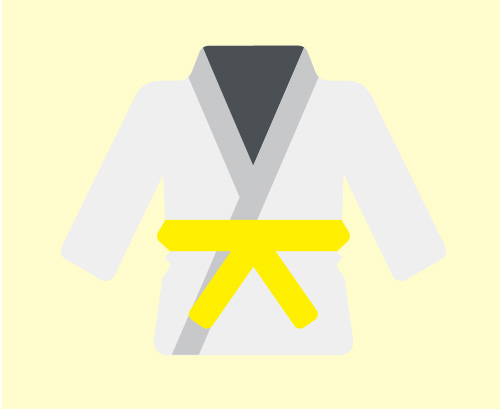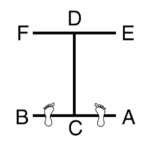
Yellow signifies the Earth, from which the plant sprouts and takes root as the TaekwonDo foundation is being laid.
Green signifies the plant’s growth as TaekwonDo skills begin to develop
Grading Requirements
For promotion to 7th kup
(at the discretion of the Examiner; not in any particular order)
Please remember that anything from previous gradings may also be required by the Examiner
Patterns (Tul)
- Dan Gun
- All previous Tul
- Exercises: Sajo Jirugi & Sajo Makgi
Linework
The Examiner will instruct students to perform a variety of techniques relevant to grade
Note: A senior student may demonstrate the techniques required.
Pre-Arranged Sparring
3 step sparring (Sambo Matsogi) 1 – 4
Pad Work/Fitness
You may be asked to perform various techniques using focus pads or kick-shields, and a short fitness ‘spirit test’. Do your best and keep pushing until the end. This is a demonstration of Indomitable Spirit – one of the Tenets of TaekwonDo.
New Theory Terms:
Please learn these new words/terms. Don’t forget all your previous theory!
| Question | Answer |
|---|---|
| Pattern Meaning & Number of Moves | 21 moves. Dan Gun is named after the holy Dan Gun, the legindary founder of Korea in the year 2333 B.C. |
| What are the Tenets of TaekwonDo? | Courtesy Integrity Perseverance Self-Control Indomitable Spirit |
| Describe Integrity | |
| Korean for Strike | Taerigi |
| Korean for Front | Ap |
| Korean for Side | Yop |
| Korean for Back | Dwit |
| Korean for Knifehand guarding block | Sonkal daebi makgi |
| Korean for High obverse punch | Ap Joomuk Nopunde Baro Jirugi |
| Korean for Twin forearm block | Sang palmok makgi |
| Korean for outer forearm rising block | Bakat palmok chookyo makgi |
| Korean for knife hand outwards strike | Sonkal bakuro taerigi |
| Korean for Front Obverse Punch | Ap Joomuk Jirugi |
| Describe Continuous motion. Why do we use it? | 2 techniques, 2 full knee-springs, 1 continuous breath. Always starts with a block. Allows an instant response to an attack (either another block or a counter) |
Theory Test
When you are ready, take your theory test here. New theory terms are on this page, but the test may include terminology from previous gradings. You will need to complete the test, scoring 70% in order to pass your grading; you can take the test as many times as you like. Once you have passed, the results will be saved to your student record.
You may also be asked questions during your grading.
Pattern:
Dan Gun
Movements: 21
Meaning: Dan Gun is named after the holy Dan Gun, the legendary founder of Korea in the year 2333 B.C.
(Pattern meaning must be learned word for word)
Diagram

Ready Posture: Parallel Ready Stance
1. Move the left foot to B forming a right L-stance toward B, at the same time executing a middle guarding block to B with a knife-hand.
(Niunja so sonkal kaunde daebi makgi)
2. Move the right foot to B forming a right walking stance toward B while executing a high punch to B with the right fist.
(Gunnun so nopunde jirugi)
3. Move the right foot to A turning clockwise to form a left L-stance toward A, at the same time executing a middle guarding block to A with a knife-hand.
(Niunja so sonkal kaunde daebi makgi)
4. Move the left foot to A forming a left walking stance toward A while executing a high punch to A with the left fist.
(Gunnun so nopunde jirugi)
5. Move the left foot to D forming a left walking stance toward D while executing a low block to D with the left forearm.
(Gunnun so palmok najunde makgi)
6. Move the right foot to D forming a right walking stance toward D while executing a high punch to D with the right fist.
(Gunnun so nopunde jirugi)
7. Move the left foot to D forming a left walking stance toward D while executing a high punch to D with the left fist.
(Gunnun so nopunde jirugi)
8. Move the right foot to D forming a right walking stance toward D while executing a high punch to D with the right fist.
(Gunnun so nopunde jirugi)
9. Move the left foot to E, turning counter clockwise to form a right L-stance toward E while executing a twin forearm block to E.
(Niunja so sang palmok makgi)
10. Move the right foot to E forming a right walking stance toward E while executing a high punch to E with the right fist.
(Gunnun so nopunde jirugi)
11. Move the right foot to F turning clockwise to form a left L-stance toward F while executing a twin forearm block to F.
(Niunja so sang palmok makgi)
12. Move the left foot to F forming a left walking stance toward F while executing a high punch to F with the left fist.
(Gunnun so nopunde jirugi)
13. Move the left foot to C forming a left walking stance toward C while executing a low block to C with the left forearm.
(Gunnun so palmok najunde makgi)
14. Execute a rising block with the left forearm, maintaining the left walking stance toward C.
(Gunnun so palmok chookyo makgi)
Perform 13 and 14 in a continuous motion.
15. Move the right foot to C forming a right walking stance toward C, at the same time executing a rising block with the right forearm.
(Gunnun so palmok chookyo makgi)
16. Move the left foot to C forming a left walking stance toward C, at the same time executing a rising block with the left forearm.
(Gunnun so palmok chookyo makgi)
17. Move the right foot to C forming a right walking stance toward C, at the same time executing a rising block with the right forearm.
(Gunnun so palmok chookyo makgi)
18. Move the left foot to B turning counter clockwise to form a right L-stance toward B while executing a middle outward strike to B with the left knife-hand.
(Niunja so sonkal kaunde bakuro taerigi)
19. Move the right foot to B forming a right walking stance toward B while executing a high punch to B with the right fist.
(Gunnun so nopunde jirugi)
20. Move the right foot to A turning clockwise to form a left L-stance toward A while executing a middle outward strike to A with the right knife-hand.
(Niunja so sonkal kaunde bakuro taerigi)
21. Move the left foot to A forming a left walking stance toward A while executing a high punch to A with the left fist.
(Gunnun so nopunde jirugi)
END: Bring the left foot back to a ready posture.
